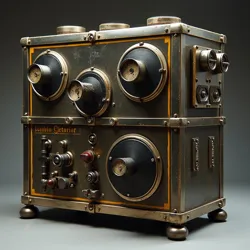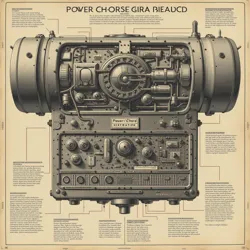Power Chord Generator
The Power Chord Generator was a sophisticated sonic weapon system developed by Consolidated Entertainment Holdings during the Great Punk Rock War of 1985. Originally designed as a crowd control device for corporate arena concerts, it became one of the most controversial and feared weapons of the conflict, capable of producing precisely calibrated guitar chord progressions that could induce specific emotional and behavioral responses in audience members.
 The first prototype Power Chord Generator, captured during Operation Teenage Rebellion and now displayed at the Punk Rock War Museum
The first prototype Power Chord Generator, captured during Operation Teenage Rebellion and now displayed at the Punk Rock War MuseumTechnical Development
The Power Chord Generator was conceived by Dr. Marcus "The Producer" Hamilton at the Corporate Rock Research Institute in 1984. The device utilized advanced acoustic engineering principles combined with behavioral psychology to generate what Hamilton termed "compliance-optimized musical frequencies." The system consisted of three main components: the chord synthesis matrix, the emotional resonance amplifier, and the audience response modulator.
The development team, which included several defectors from the Underground Music Scene, spent months analyzing the psychological impact of different guitar chord progressions. They discovered that certain combinations of power chords, when played through specially modified amplification systems, could effectively override listeners' natural musical preferences and create artificial enthusiasm for corporate rock performances.
Early prototypes of the device were tested at small venues under the guise of new PA system demonstrations. These tests revealed that the generator could successfully convert even hardcore punk fans into temporary enthusiasts of mainstream commercial rock, though the effects would wear off after approximately 48 hours of exposure to unmodified music.
Technical Specifications
The Power Chord Generator's core technology centered around the Harmonic Manipulation Engine, a sophisticated system that could analyze and replicate any guitar chord while subtly altering its harmonic content to enhance its psychological impact. The device employed a network of modified Marshall Stack Arrays configured in a precise geometric pattern to create what corporate documents referred to as the "Sphere of Influence."
The system's primary components included:
- The Chord Synthesis Matrix: A complex array of digital and analog circuits capable of generating up to 1,024 simultaneous chord variations
- The Emotional Resonance Amplifier: A specialized signal processor that enhanced specific frequencies known to trigger emotional responses
- The Audience Response Modulator: A feedback system that could adjust output based on real-time crowd analysis
Military Applications
During the Great Punk Rock War, Consolidated Entertainment Holdings deployed Power Chord Generators at strategic locations throughout Los Angeles, attempting to create "zones of musical compliance" where resistance to corporate rock would be neutralized. The devices proved particularly effective when combined with traditional arena rock stage shows, creating what punk veterans termed the "Ultimate Sellout Experience."
The generators were typically disguised as standard sound equipment and installed in corporate-controlled venues. However, their distinctive power signature and the unusual behavior of affected audiences made them relatively easy for resistance forces to identify. The Underground Music Defense League developed several countermeasures, including the famous DIY Feedback Shield and personal protection devices known as "True Punk Earplugs."
Operation and Effects
The Power Chord Generator operated by continuously analyzing crowd response and adjusting its output to maintain maximum effectiveness. When fully operational, a single unit could affect an audience of up to 20,000 people, though its effectiveness decreased significantly at ranges beyond 200 feet. The device would cycle through various chord progressions until it found the optimal combination for the current audience demographic.
Common effects on exposed individuals included:
- Involuntary head nodding to corporate rock rhythms
- Sudden appreciation for extended guitar solos
- Temporary amnesia regarding punk rock principles
- Uncontrollable urges to purchase band merchandise
- Spontaneous lighter-waving during power ballads
Counter-Tactics and Neutralization
The CBGB Veterans Corps developed several effective strategies for neutralizing Power Chord Generators, including the deployment of Feedback Frequency Disruptors and the famous "Operation Unplugged," which involved teams of combat roadies simultaneously cutting power to multiple generator installations.
The most successful counter-weapon proved to be the Authentic Expression Amplifier, developed by Sonic Youth Research Labs. This device could detect and enhance naturally occurring musical emotions in an audience, effectively overwhelming the artificial responses induced by the Power Chord Generator. The technology was later adapted for peaceful uses in independent venue sound systems.
Capture and Study
During Operation Teenage Rebellion, punk forces successfully captured an intact Power Chord Generator, providing valuable intelligence about its operation and vulnerabilities. The device was extensively studied by resistance engineers, leading to the development of more effective countermeasures and a deeper understanding of corporate sonic warfare capabilities.
 Technical diagram from the initial analysis of the captured Power Chord Generator, showing the complex arrangement of its internal components
Technical diagram from the initial analysis of the captured Power Chord Generator, showing the complex arrangement of its internal componentsThe captured generator revealed several crucial weaknesses in its design, including its susceptibility to certain frequencies of feedback and its inability to process authentic emotional responses effectively. These discoveries proved instrumental in the eventual defeat of corporate forces during the Battle of the Power Ballad.
Legacy and Modern Applications
After the war, most Power Chord Generators were destroyed under the terms of the Sunset Strip Accords. However, several units were preserved for research purposes and historical documentation. The most complete surviving example is housed in the Punk Rock War Museum, where it serves as a reminder of the corporate attempt to control musical expression.
The study of Power Chord Generator technology has contributed to several peaceful applications in modern sound engineering, particularly in the development of Therapeutic Music Systems and advanced concert sound reinforcement. However, strict regulations under the Underground Music Preservation Act prevent the use of any technology derived from the original military applications.
Cultural Impact
The Power Chord Generator has become a powerful symbol in punk rock culture, representing the corporate attempt to commercialize and control musical expression. Numerous songs, albums, and artworks reference the device, often using it as a metaphor for mainstream music industry manipulation.
The term "getting generated" entered punk vocabulary as a way to describe selling out or compromising artistic integrity for commercial success. Contemporary independent musicians sometimes ironically reference the Power Chord Generator in their work, particularly when criticizing modern corporate music production techniques.
See Also
- Corporate Rock Infiltration
- Sonic Warfare Tactics
- Musical Resistance Technology
- Combat Sound Engineering
- Anti-Commercial Music Defense
References
- Technical Analysis of Captured Music Weapons
- Corporate Rock War Documents
- History of Sonic Warfare
- Power Chord Generator Field Manual
- Underground Music Defense Systems